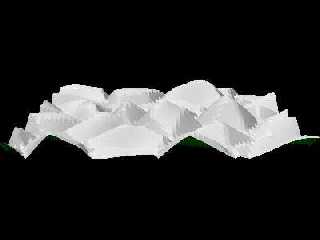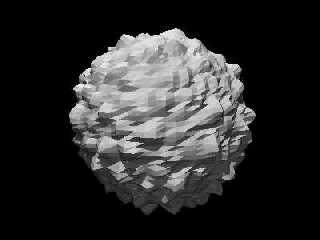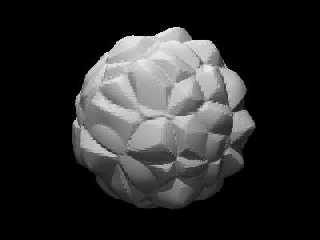 |
 |
|
 |
|
 |
|  |
|  |
|
 |
|
 |
|  |
|  |
|
 |
These macros generate height field meshes from pigments from within POV.
SquareHF.jpeg is an ordinary square height field, like the
height_field {} primitive object in POV.
SphereHF.jpeg is the first type of spherical height field, using a 2D
square wrapped around a sphere with spherical coordinates.
Sphere2HF.jpeg is the second type of spherical height field, generated
by recursively subdividing an octahedron, dividing each triangle into 4
triangles. This doesn't have the "pinching" toward the y axis like the
first type does.
I still haven't done smoothing, I'll try to figure out a good way to do
it.
--
Christopher James Huff
Personal: chr### [at] mac com, http://homepage.mac.com/chrishuff/
TAG: chr### [at] tag com, http://homepage.mac.com/chrishuff/
TAG: chr### [at] tag povray povray org, http://tag.povray.org/
<>< org, http://tag.povray.org/
<><
Post a reply to this message
Attachments:
Download 'SquareHF.jpeg.jpg' (6 KB)
Download 'SphereHF.jpeg.jpg' (9 KB)
Download 'Sphere2HF.jpeg.jpg' (6 KB)
Preview of image 'SquareHF.jpeg.jpg'

Preview of image 'SphereHF.jpeg.jpg'

Preview of image 'Sphere2HF.jpeg.jpg'

|
 |
|  |
|  |
|
 |
From: Tony[B]
Subject: Re: Height field macros - attached files (1/1)
Date: 3 Mar 2001 14:07:08
Message: <3aa140dc@news.povray.org>
|
|
 |
|  |
|  |
|
 |
Um, I don't get it, but this is cool.
Post a reply to this message
|
 |
|  |
|  |
|
 |
|
 |
|  |
|  |
|
 |
Cylindrical and spherical height fields are a MegaPOV feature, right? I
didn't realize there was any kind of default height_field {} object, but
that's very interesting as well. Did you use the smooth command in the
height_field? Maybe you could increase the resolution of your height_field
image (if you used one.... I'm a little unclear exactly what you've done
here, but it's very interesting).
Stephen
"Chris Huff" <chr### [at] mac com> wrote in message
news:chrishuff-26BCD9.13120903032001@news.povray.org...
> These macros generate height field meshes from pigments from within POV.
>
> SquareHF.jpeg is an ordinary square height field, like the
> height_field {} primitive object in POV.
>
> SphereHF.jpeg is the first type of spherical height field, using a 2D
> square wrapped around a sphere with spherical coordinates.
>
> Sphere2HF.jpeg is the second type of spherical height field, generated
> by recursively subdividing an octahedron, dividing each triangle into 4
> triangles. This doesn't have the "pinching" toward the y axis like the
> first type does.
>
> I still haven't done smoothing, I'll try to figure out a good way to do
> it.
>
> --
> Christopher James Huff
> Personal: chr### [at] mac com> wrote in message
news:chrishuff-26BCD9.13120903032001@news.povray.org...
> These macros generate height field meshes from pigments from within POV.
>
> SquareHF.jpeg is an ordinary square height field, like the
> height_field {} primitive object in POV.
>
> SphereHF.jpeg is the first type of spherical height field, using a 2D
> square wrapped around a sphere with spherical coordinates.
>
> Sphere2HF.jpeg is the second type of spherical height field, generated
> by recursively subdividing an octahedron, dividing each triangle into 4
> triangles. This doesn't have the "pinching" toward the y axis like the
> first type does.
>
> I still haven't done smoothing, I'll try to figure out a good way to do
> it.
>
> --
> Christopher James Huff
> Personal: chr### [at] mac com, http://homepage.mac.com/chrishuff/
> TAG: chr### [at] tag com, http://homepage.mac.com/chrishuff/
> TAG: chr### [at] tag povray povray org, http://tag.povray.org/
>
> <><
>
> org, http://tag.povray.org/
>
> <><
>
>
Post a reply to this message
|
 |
|  |
|  |
|
 |
From: Christoph Hormann
Subject: Re: Height field macros - attached files (1/1)
Date: 3 Mar 2001 17:17:19
Message: <3AA16D6D.72C85D84@gmx.de>
|
|
 |
|  |
|  |
|
 |
Chris Huff wrote:
>
> These macros generate height field meshes from pigments from within POV.
>
> SquareHF.jpeg is an ordinary square height field, like the
> height_field {} primitive object in POV.
>
> SphereHF.jpeg is the first type of spherical height field, using a 2D
> square wrapped around a sphere with spherical coordinates.
>
> Sphere2HF.jpeg is the second type of spherical height field, generated
> by recursively subdividing an octahedron, dividing each triangle into 4
> triangles. This doesn't have the "pinching" toward the y axis like the
> first type does.
>
> I still haven't done smoothing, I'll try to figure out a good way to do
> it.
>
Looks very interesting, although i did not yet totally understand how the
second and third one work, are you evaluating the pigment in a 2d plane or
in 3d space?
The third one looks similar to a sphere-crackle isosurface, that lead me
to the idea of an isosurface tesselation macro. Since Warp's tesselation
patch is still buggy and does not work well on isosurfaces, that could be
quite useful IMO.
Christoph
--
Christoph Hormann <chr### [at] gmx de>
IsoWood include, radiosity tutorial, TransSkin and other
things on: http://www.schunter.etc.tu-bs.de/~chris/ de>
IsoWood include, radiosity tutorial, TransSkin and other
things on: http://www.schunter.etc.tu-bs.de/~chris/
Post a reply to this message
|
 |
|  |
|  |
|
 |
|
 |
|  |
|  |
|
 |
In article <3AA16D6D.72C85D84@gmx.de>, Christoph Hormann
<chr### [at] gmx de> wrote:
> Looks very interesting, although i did not yet totally understand how the
> second and third one work, are you evaluating the pigment in a 2d plane or
> in 3d space?
3D space, the surface of a 1-unit-radius sphere centered at < 0, 0,
0>...you could map the sphere to a 2D plane with the spherical warp, if
you wanted, but this method lets you get completely smooth, continuous
results.
> The third one looks similar to a sphere-crackle isosurface, that lead me
> to the idea of an isosurface tesselation macro. Since Warp's tesselation
> patch is still buggy and does not work well on isosurfaces, that could be
> quite useful IMO.
This would be extremely slow as a macro or include...maybe too slow to
be practical. Also, as I recall, Warp's tesselation patch works fine
with isosurfaces using method 2, and the problem with method 1 is
actually with the isosurface object itself, not the tesselation patch.
There is that odd bug with missing/misarranged triangles, but that often
doesn't pop up.
--
Christopher James Huff
Personal: chr### [at] mac de> wrote:
> Looks very interesting, although i did not yet totally understand how the
> second and third one work, are you evaluating the pigment in a 2d plane or
> in 3d space?
3D space, the surface of a 1-unit-radius sphere centered at < 0, 0,
0>...you could map the sphere to a 2D plane with the spherical warp, if
you wanted, but this method lets you get completely smooth, continuous
results.
> The third one looks similar to a sphere-crackle isosurface, that lead me
> to the idea of an isosurface tesselation macro. Since Warp's tesselation
> patch is still buggy and does not work well on isosurfaces, that could be
> quite useful IMO.
This would be extremely slow as a macro or include...maybe too slow to
be practical. Also, as I recall, Warp's tesselation patch works fine
with isosurfaces using method 2, and the problem with method 1 is
actually with the isosurface object itself, not the tesselation patch.
There is that odd bug with missing/misarranged triangles, but that often
doesn't pop up.
--
Christopher James Huff
Personal: chr### [at] mac com, http://homepage.mac.com/chrishuff/
TAG: chr### [at] tag com, http://homepage.mac.com/chrishuff/
TAG: chr### [at] tag povray povray org, http://tag.povray.org/
<>< org, http://tag.povray.org/
<><
Post a reply to this message
|
 |
|  |
|  |
|
 |
|
 |
|  |
|  |
|
 |
In article <3aa16d04$1@news.povray.org>, "Stephen Bell"
<ste### [at] yahoo com> wrote:
> Cylindrical and spherical height fields are a MegaPOV feature, right?
No.
> I didn't realize there was any kind of default height_field {}
> object, but that's very interesting as well.
The height_field {} object only does "square patch" height fields.
> Did you use the smooth command in the height_field?
"I still haven't done smoothing, I'll try to figure out a good way to do
it."
Your question seems a bit odd, though...no, I didn't use the smooth
command, I didn't even use the height_field object. These macros
generate meshes.
> Maybe you could increase the resolution of your height_field image
> (if you used one.... I'm a little unclear exactly what you've done
> here, but it's very interesting).
No image was used, just a simple crackle pigment.
--
Christopher James Huff
Personal: chr### [at] mac com> wrote:
> Cylindrical and spherical height fields are a MegaPOV feature, right?
No.
> I didn't realize there was any kind of default height_field {}
> object, but that's very interesting as well.
The height_field {} object only does "square patch" height fields.
> Did you use the smooth command in the height_field?
"I still haven't done smoothing, I'll try to figure out a good way to do
it."
Your question seems a bit odd, though...no, I didn't use the smooth
command, I didn't even use the height_field object. These macros
generate meshes.
> Maybe you could increase the resolution of your height_field image
> (if you used one.... I'm a little unclear exactly what you've done
> here, but it's very interesting).
No image was used, just a simple crackle pigment.
--
Christopher James Huff
Personal: chr### [at] mac com, http://homepage.mac.com/chrishuff/
TAG: chr### [at] tag com, http://homepage.mac.com/chrishuff/
TAG: chr### [at] tag povray povray org, http://tag.povray.org/
<>< org, http://tag.povray.org/
<><
Post a reply to this message
|
 |
|  |
|  |
|
 |
From: Stephen Bell
Subject: Re: Height field macros - attached files (1/1)
Date: 4 Mar 2001 02:36:46
Message: <3aa1f08e@news.povray.org>
|
|
 |
|  |
|  |
|
 |
Okay, I finally understand what you're talking about. Sorry to ask stupid
questions.
"Chris Huff" <chr### [at] mac com> wrote in message
news:chrishuff-359426.22352703032001@news.povray.org...
> In article <3aa16d04$1@news.povray.org>, "Stephen Bell"
> <ste### [at] yahoo com> wrote in message
news:chrishuff-359426.22352703032001@news.povray.org...
> In article <3aa16d04$1@news.povray.org>, "Stephen Bell"
> <ste### [at] yahoo com> wrote:
>
> > Cylindrical and spherical height fields are a MegaPOV feature, right?
>
> No.
>
>
> > I didn't realize there was any kind of default height_field {}
> > object, but that's very interesting as well.
>
> The height_field {} object only does "square patch" height fields.
>
>
> > Did you use the smooth command in the height_field?
>
> "I still haven't done smoothing, I'll try to figure out a good way to do
> it."
> Your question seems a bit odd, though...no, I didn't use the smooth
> command, I didn't even use the height_field object. These macros
> generate meshes.
>
>
> > Maybe you could increase the resolution of your height_field image
> > (if you used one.... I'm a little unclear exactly what you've done
> > here, but it's very interesting).
>
> No image was used, just a simple crackle pigment.
>
> --
> Christopher James Huff
> Personal: chr### [at] mac com> wrote:
>
> > Cylindrical and spherical height fields are a MegaPOV feature, right?
>
> No.
>
>
> > I didn't realize there was any kind of default height_field {}
> > object, but that's very interesting as well.
>
> The height_field {} object only does "square patch" height fields.
>
>
> > Did you use the smooth command in the height_field?
>
> "I still haven't done smoothing, I'll try to figure out a good way to do
> it."
> Your question seems a bit odd, though...no, I didn't use the smooth
> command, I didn't even use the height_field object. These macros
> generate meshes.
>
>
> > Maybe you could increase the resolution of your height_field image
> > (if you used one.... I'm a little unclear exactly what you've done
> > here, but it's very interesting).
>
> No image was used, just a simple crackle pigment.
>
> --
> Christopher James Huff
> Personal: chr### [at] mac com, http://homepage.mac.com/chrishuff/
> TAG: chr### [at] tag com, http://homepage.mac.com/chrishuff/
> TAG: chr### [at] tag povray povray org, http://tag.povray.org/
>
> <>< org, http://tag.povray.org/
>
> <><
Post a reply to this message
|
 |
|  |
|  |
|
 |
From: Christoph Hormann
Subject: Re: Height field macros - attached files (1/1)
Date: 4 Mar 2001 03:40:46
Message: <3AA1FF8E.8F2568B4@gmx.de>
|
|
 |
|  |
|  |
|
 |
Chris Huff wrote:
>
> 3D space, the surface of a 1-unit-radius sphere centered at < 0, 0,
> 0>...you could map the sphere to a 2D plane with the spherical warp, if
> you wanted, but this method lets you get completely smooth, continuous
> results.
>
Still didn't get it totally, but i suppose you will post some code
sometime.
> [...]
> This would be extremely slow as a macro or include...maybe too slow to
> be practical. Also, as I recall, Warp's tesselation patch works fine
> with isosurfaces using method 2, and the problem with method 1 is
> actually with the isosurface object itself, not the tesselation patch.
> There is that odd bug with missing/misarranged triangles, but that often
> doesn't pop up.
I have never gotten acceptable results with the tesselation patch on
isosurfaces. I also remember that 'trace' does not work correctly on
method 2 isosurfaces and IIRC the tesselation patch uses the same
mechanism.
The nice thing about this method is, that it would not use the actual
object but the isosurface function. My main idea for usage was to speed
up those endless isosurface - radiosity renders and in that case speed is
not so much a problem. One could save the mesh once it's generated and
reuse it.
Christoph
--
Christoph Hormann <chr### [at] gmx de>
IsoWood include, radiosity tutorial, TransSkin and other
things on: http://www.schunter.etc.tu-bs.de/~chris/ de>
IsoWood include, radiosity tutorial, TransSkin and other
things on: http://www.schunter.etc.tu-bs.de/~chris/
Post a reply to this message
|
 |
|  |
|  |
|
 |
|
 |
|  |
|  |
|
 |
In article <3AA1FF8E.8F2568B4@gmx.de>, Christoph Hormann
<chr### [at] gmx de> wrote:
> Still didn't get it totally, but i suppose you will post some code
> sometime.
What about it don't you get?
> I have never gotten acceptable results with the tesselation patch on
> isosurfaces. I also remember that 'trace' does not work correctly on
> method 2 isosurfaces and IIRC the tesselation patch uses the same
> mechanism.
I had them backwards...it's method 2 isosurfaces that have the problem.
> The nice thing about this method is, that it would not use the actual
> object but the isosurface function.
That would only work for a limited number of isosurfaces...it could
replace some uses of isosurfaces, but it's an inexact replacement. The
macros do displacement mapping on specific objects, not an equipotential
surface. All these macros could do is basic displacements on spheres and
square patches (eventually discs, cylinders, cones, and torii), but
isosurfaces can do much more. In addition, a mesh generated with these
macros will consume much more memory.
--
Christopher James Huff
Personal: chr### [at] mac de> wrote:
> Still didn't get it totally, but i suppose you will post some code
> sometime.
What about it don't you get?
> I have never gotten acceptable results with the tesselation patch on
> isosurfaces. I also remember that 'trace' does not work correctly on
> method 2 isosurfaces and IIRC the tesselation patch uses the same
> mechanism.
I had them backwards...it's method 2 isosurfaces that have the problem.
> The nice thing about this method is, that it would not use the actual
> object but the isosurface function.
That would only work for a limited number of isosurfaces...it could
replace some uses of isosurfaces, but it's an inexact replacement. The
macros do displacement mapping on specific objects, not an equipotential
surface. All these macros could do is basic displacements on spheres and
square patches (eventually discs, cylinders, cones, and torii), but
isosurfaces can do much more. In addition, a mesh generated with these
macros will consume much more memory.
--
Christopher James Huff
Personal: chr### [at] mac com, http://homepage.mac.com/chrishuff/
TAG: chr### [at] tag com, http://homepage.mac.com/chrishuff/
TAG: chr### [at] tag povray povray org, http://tag.povray.org/
<>< org, http://tag.povray.org/
<><
Post a reply to this message
|
 |
|  |
|  |
|
 |
From: Christoph Hormann
Subject: Re: Height field macros - attached files (1/1)
Date: 4 Mar 2001 12:33:19
Message: <3AA27C54.A661D09B@gmx.de>
|
|
 |
|  |
|  |
|
 |
Chris Huff wrote:
>
> That would only work for a limited number of isosurfaces...it could
> replace some uses of isosurfaces, but it's an inexact replacement. The
> macros do displacement mapping on specific objects, not an equipotential
> surface. All these macros could do is basic displacements on spheres and
> square patches (eventually discs, cylinders, cones, and torii), but
> isosurfaces can do much more. In addition, a mesh generated with these
> macros will consume much more memory.
>
I didn't mean to use excatly the same macros, just got the idea from your
pictures. Maybe i will work it out sometime...
I think i also understand better now how it works, more like a displace
warp for the surface, right?
Christoph
--
Christoph Hormann <chr### [at] gmx de>
IsoWood include, radiosity tutorial, TransSkin and other
things on: http://www.schunter.etc.tu-bs.de/~chris/ de>
IsoWood include, radiosity tutorial, TransSkin and other
things on: http://www.schunter.etc.tu-bs.de/~chris/
Post a reply to this message
|
 |
|  |
|  |
|
 |
|
 |
|  |
|
 |




![]()